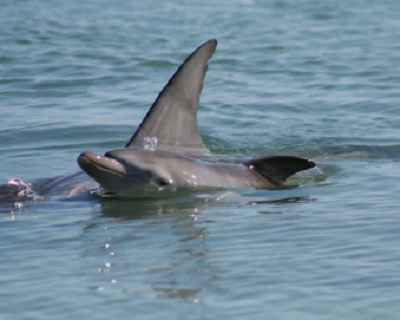Indo-Pacific Bottlenose Dolphin
Bottlenose dolphin
Tursiops aduncus and T. truncatus
Description

| Length 2.6-4m |
Weight 120-650kg |
Lifespan 30-40yrs |
There are two species of bottlenose dolphins—the common bottlenose dolphin (Tursiops truncatus) and IndoPacific bottlenose dolphin (T. aduncus). The Indo-Pacific has more teeth, is smaller, and has spots on its belly. The prominent melon (forehead) of dolphins contains oily fat and is probably used for echolocation, helping to produce the whistles, clicks and pulses used to find food.
Diet

The Monkey Mia dolphin population forms small subgroups in a defined home range. Group members help each other rear calves and cooperate when hunting. Their diet includes fish, squid and crustaceans. Some dolphins in Shark Bay use sea sponges to protect their sensitive rostrums from injury when digging fish out of the sand.
Breeding

| Incubation 12 months |
No. young 1 |
Weaned 3-4 years |
Male bottlenose dolphins can live 30 to 35 years, and females up to 40 years. Females begin breeding at about 10 to 12 years and can have one calf every three to four years. When mating, a group of males try to keep rival groups away from a female while members of the group take turns to mate with her.
Distribution and habitat

More than 2000 dolphins inhabit Shark Bay and there are about 200 in the Monkey Mia area. The dolphins in Shark Bay are mostly Indo-Pacific bottlenose dolphins (T. aduncus). Scientists identify individuals by their large, slightly hooked dorsal fins which are uniquely shaped and scarred.
Status
The Indo-Pacific bottlenose dolphin is listed as ‘data deficient’ on the IUCN’s Red List because it was not known as a separate species before 1998 and this is reflected in scientific data. The common bottlenose dolphin is considered abundant, although habitat degradation and pollution are of increasing concern.
Fact sheet
SHARK BAY
World Heritage



